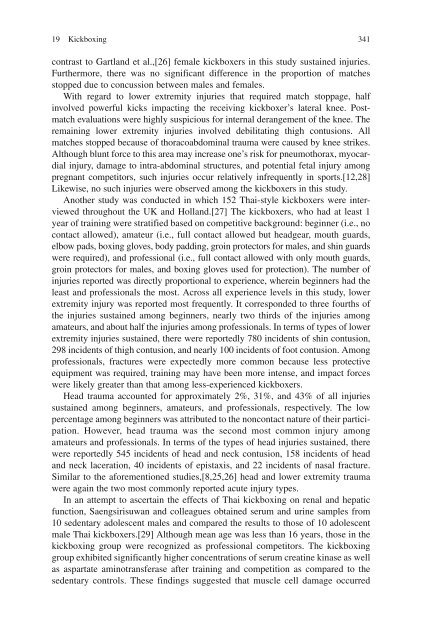Nutrition in Combat Sports
Nutrition in Combat Sports
Nutrition in Combat Sports
You also want an ePaper? Increase the reach of your titles
YUMPU automatically turns print PDFs into web optimized ePapers that Google loves.
19 Kickbox<strong>in</strong>g 341<br />
contrast to Gartland et al., [26] female kickboxers <strong>in</strong> this study susta<strong>in</strong>ed <strong>in</strong>juries.<br />
Furthermore, there was no significant difference <strong>in</strong> the proportion of matches<br />
stopped due to concussion between males and females.<br />
With regard to lower extremity <strong>in</strong>juries that required match stoppage, half<br />
<strong>in</strong>volved powerful kicks impact<strong>in</strong>g the receiv<strong>in</strong>g kickboxer’s lateral knee. Postmatch<br />
evaluations were highly suspicious for <strong>in</strong>ternal derangement of the knee. The<br />
rema<strong>in</strong><strong>in</strong>g lower extremity <strong>in</strong>juries <strong>in</strong>volved debilitat<strong>in</strong>g thigh contusions. All<br />
matches stopped because of thoracoabdom<strong>in</strong>al trauma were caused by knee strikes.<br />
Although blunt force to this area may <strong>in</strong>crease one’s risk for pneumothorax, myocardial<br />
<strong>in</strong>jury, damage to <strong>in</strong>tra-abdom<strong>in</strong>al structures, and potential fetal <strong>in</strong>jury among<br />
pregnant competitors, such <strong>in</strong>juries occur relatively <strong>in</strong>frequently <strong>in</strong> sports. [12, 28]<br />
Likewise, no such <strong>in</strong>juries were observed among the kickboxers <strong>in</strong> this study.<br />
Another study was conducted <strong>in</strong> which 152 Thai-style kickboxers were <strong>in</strong>terviewed<br />
throughout the UK and Holland. [27] The kickboxers, who had at least 1<br />
year of tra<strong>in</strong><strong>in</strong>g were stratified based on competitive background: beg<strong>in</strong>ner (i.e., no<br />
contact allowed), amateur (i.e., full contact allowed but headgear, mouth guards,<br />
elbow pads, box<strong>in</strong>g gloves, body padd<strong>in</strong>g, gro<strong>in</strong> protectors for males, and sh<strong>in</strong> guards<br />
were required), and professional (i.e., full contact allowed with only mouth guards,<br />
gro<strong>in</strong> protectors for males, and box<strong>in</strong>g gloves used for protection). The number of<br />
<strong>in</strong>juries reported was directly proportional to experience, where<strong>in</strong> beg<strong>in</strong>ners had the<br />
least and professionals the most. Across all experience levels <strong>in</strong> this study, lower<br />
extremity <strong>in</strong>jury was reported most frequently. It corresponded to three fourths of<br />
the <strong>in</strong>juries susta<strong>in</strong>ed among beg<strong>in</strong>ners, nearly two thirds of the <strong>in</strong>juries among<br />
amateurs, and about half the <strong>in</strong>juries among professionals. In terms of types of lower<br />
extremity <strong>in</strong>juries susta<strong>in</strong>ed, there were reportedly 780 <strong>in</strong>cidents of sh<strong>in</strong> contusion,<br />
298 <strong>in</strong>cidents of thigh contusion, and nearly 100 <strong>in</strong>cidents of foot contusion. Among<br />
professionals, fractures were expectedly more common because less protective<br />
equipment was required, tra<strong>in</strong><strong>in</strong>g may have been more <strong>in</strong>tense, and impact forces<br />
were likely greater than that among less-experienced kickboxers.<br />
Head trauma accounted for approximately 2%, 31%, and 43% of all <strong>in</strong>juries<br />
susta<strong>in</strong>ed among beg<strong>in</strong>ners, amateurs, and professionals, respectively. The low<br />
percentage among beg<strong>in</strong>ners was attributed to the noncontact nature of their participation.<br />
However, head trauma was the second most common <strong>in</strong>jury among<br />
amateurs and professionals. In terms of the types of head <strong>in</strong>juries susta<strong>in</strong>ed, there<br />
were reportedly 545 <strong>in</strong>cidents of head and neck contusion, 158 <strong>in</strong>cidents of head<br />
and neck laceration, 40 <strong>in</strong>cidents of epistaxis, and 22 <strong>in</strong>cidents of nasal fracture.<br />
Similar to the aforementioned studies, [8, 25, 26] head and lower extremity trauma<br />
were aga<strong>in</strong> the two most commonly reported acute <strong>in</strong>jury types.<br />
In an attempt to ascerta<strong>in</strong> the effects of Thai kickbox<strong>in</strong>g on renal and hepatic<br />
function, Saengsirisuwan and colleagues obta<strong>in</strong>ed serum and ur<strong>in</strong>e samples from<br />
10 sedentary adolescent males and compared the results to those of 10 adolescent<br />
male Thai kickboxers. [29] Although mean age was less than 16 years, those <strong>in</strong> the<br />
kickbox<strong>in</strong>g group were recognized as professional competitors. The kickbox<strong>in</strong>g<br />
group exhibited significantly higher concentrations of serum creat<strong>in</strong>e k<strong>in</strong>ase as well<br />
as aspartate am<strong>in</strong>otransferase after tra<strong>in</strong><strong>in</strong>g and competition as compared to the<br />
sedentary controls. These f<strong>in</strong>d<strong>in</strong>gs suggested that muscle cell damage occurred

















